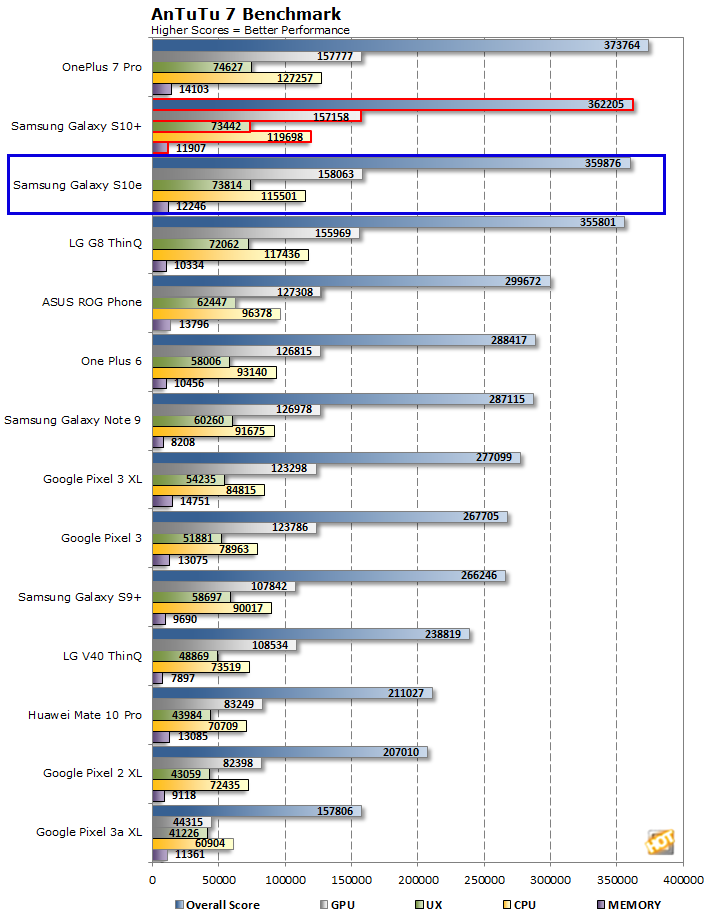For our firsts set of tests, we're using the JetStream
benchmark to evaluate Javascript
performance and RightWare’s Web Test 3.0 for a more comprehensive, mixed-media web performance analysis, which includes HTML5
rendering. Here we'll primarily determine how Samsung's Galaxy S10e, with 6GB of RAM and a Snapdragon 855 SoC, handles this workload with the Chrome web browser. All tests were performed at the phone's default display resolution.
 |
|
JetStream And Basemark Web 3.0 |
| JavaScript and Browser Testing |
|


The top few slots are all occupied by phones sporting a Snapdragon 855 processor, and we see the Galaxy S10e mingling accordingly. In Basemark 3.0, a small edge goes to the OnePlus 7 Pro, with its 12GB of RAM and fast UFS 3.0 storage capable of up to 2666MB/s of bandwidth (versus 1333MB/s for legacy UFS 2.1 devices), but the Galaxy S10e is right on its heels.
 |
|
GeekBench |
|
Synthetic CPU Benchmark |
|
In the GeekBench test, we're stressing only CPU cores in a handset (not graphics), with both single and multi-threaded workloads. The test is comprised of encryption processing, image compression, HTML5 parsing, physics calculations, and other general purpose compute processing.

In single-core performance, Geekbench shows the Galaxy S10e and Galaxy S10+ running neck-and-neck, with just a few points separating the two. Interestingly, the Galaxy S10e slips a bit in the multi-core test, falling below the
LG G8 ThinQ by a hair. Perhaps the small design means there is less opportunity for heat dissipation, and therefore it could be scaling back performance a tad quicker than the bigger handsets. Either way, it's still running with the fastest phones of the bunch.
 |
|
Futuremark PCMark For Android |
|
General Purpose Pocket Computing Performance Metrics |
|
Futuremark's PCMark for Android is an excellent suite of tests that we recommend for benchmarking performance of a handset in a wide range of tasks, for things like image and video editing, as well as lighter-duty workloads like email and web browsing. When you see the test running live it's clear the scripted application tests are carefully selected and tuned to make use of the platforms involved in a very controlled way.
In PCMark for Android, the Galaxy S10e further demonstrates that Samsung did not have to sacrifice performance to any significant degree in order to offer a more affordable version of the Galaxy S10. The benchmark results are right on par with the Galaxy S10+.
 |
|
AnTuTu 7 |
|
Platform Benchmarks |
|
AnTuTu’s latest benchmark returns a number of metrics ranked with somewhat nebulous scores, rather than frame rates or time to complete. We tested with the latest version of AnTuTu across an all Android platform group. AnTuTu returns four top level performance metric results that we are including here: CPU, RAM, 3D, UX (or User Experience), along with a total score.
AnTuTu paints a similar picture of performance. We see the Galaxy S10e and Galaxy S10+ trading blows, depending on the specific test. For example, the Galaxy S10+ managed to post a slightly higher overall score, while the Galaxy S10e's graphics score is a smidgen higher.
For all intents and purposes, the Galaxy S10e performs just as well as the Galaxy S10+, only in a smaller and cheaper package.
















